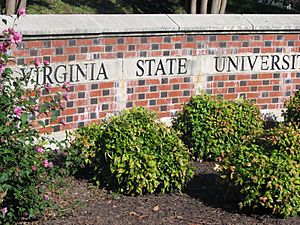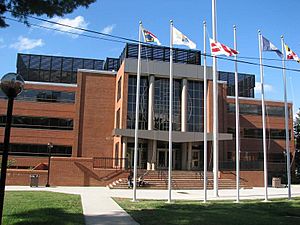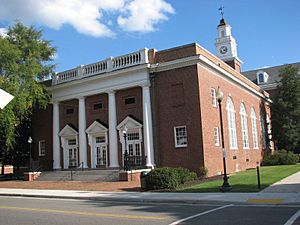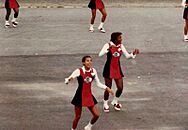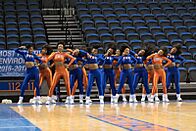Virginia State University facts for kids
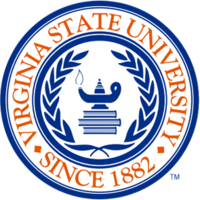 |
|
|
Former names
|
Virginia Normal and Collegiate Institute (1882–1902) Virginia State College for Negroes (1902–1946) Virginia State College (1946–1979) |
|---|---|
| Motto | "Greater Happens Here" |
| Type | Public historically black land-grant university |
| Established | March 6, 1882 |
| Accreditation | SACS |
|
Academic affiliations
|
|
| Endowment | $100 million (2025) |
| President | Makola M. Abdullah |
|
Academic staff
|
300 |
| Students | 5,701 (Fall 2024) |
| Location |
,
United States
|
| Campus | Large suburb, 236 acres (0.96 km2) |
| Newspaper | The Statesman |
| Colors | Orange and blue |
| Nickname | Trojans |
|
Sporting affiliations
|
NCAA Division II – CIAA |
 |
|
Virginia State University (VSU or Virginia State) is a public university in Ettrick, Virginia, USA. It is a historically Black university. This means it was founded to provide higher education for Black Americans. VSU is also a land-grant university, which means it receives special funding from the government to teach agriculture, science, and engineering. It was started on March 6, 1882. VSU was the first four-year college in the United States fully supported by the state for Black Americans. It is part of the Thurgood Marshall College Fund.
Contents
History of VSU
How VSU Began
Virginia State University started on March 6, 1882. The state government passed a law to create the Virginia Normal and Collegiate Institute. A Black lawyer named Alfred W. Harris helped make this law happen. There was a legal challenge that delayed the opening. But the school finally opened its doors on October 1, 1883.
Changes Over the Years
In 1902, the school's name changed to Virginia Normal and Industrial Institute. Its college program was also made smaller. Later, in 1920, a special program for Black students in agriculture and engineering moved to VSU. This program had been at a private school before.
The college program was brought back in 1923. In 1930, the school's name changed again to Virginia State College for Negroes. A two-year branch campus was added in Norfolk in 1944. This branch became a four-year college in 1956. It then became its own independent school, Norfolk State College, in 1969. The main school was renamed Virginia State College in 1946. Finally, in 1979, the state law changed its name to Virginia State University.
Growth and Development
In its first year, 1883–1884, VSU had 126 students and seven teachers. All the teachers were Black. The university had one building and a small library. By 1982, when the university was 100 years old, it had grown a lot. It had nearly 5,000 students and about 250 full-time teachers. The campus had grown to 236 acres. There were more than 50 buildings, including 15 dorms.
The university is located in Chesterfield County. It is in Ettrick, right across the Appomattox River from Petersburg. You can easily get there using major highways.
Leaders of VSU
The first person to lead the university was John Mercer Langston. He was a very famous Black man of his time. He was the only Black person elected to the U.S. Congress from Virginia until 1992. He was also the great-uncle of the famous writer Langston Hughes.
From 1888 to 1968, four presidents led the school for about 20 years each. They helped the university grow and succeed. In 2015, Dr. Pamela V. Hammond became the first woman president of Virginia State University. She was an interim president at first. On February 1, 2016, Dr. Makola Abdullah became the 14th president. He is the youngest African American to earn a Ph.D. in engineering.
In 2020, MacKenzie Scott gave $30 million to Virginia State. This was the largest single gift the university had ever received.
Campus Life
Main Campus and Facilities
The main campus of Virginia State University is about 236 acres. It also has a 412-acre farm for agricultural research. This farm is called the Randolph Farm. The main campus has over 50 buildings. These include 11 dorms and 18 academic buildings. The campus is near the Appomattox River in Ettrick, Virginia.
Student Housing
VSU has several residence halls where students can live. These include:
- Branch Hall
- Howard Hall
- Campbell Hall
- Gateway 2
- Langston Hall
- Moore Hall
- Quad Hall (buildings I&II)
- Seward Hall
- Whiting Hall
- Williams Hall
- University Apartments (off-campus)
Academics at VSU
The university offers many different subjects for students to study. These subjects are organized into seven colleges:
- College of Agriculture
- Reginald F. Lewis College of Business
- College of Education
- College of Engineering and Technology
- College of Graduate Studies, Research, and Outreach
- College of Humanities and Social Sciences
- College of Natural Sciences
Student Body
In the 2017–2018 school year, about 57% of students were female and 43% were male. Most students (nearly 70%) were from Virginia. About 97% of students lived on campus. Most students (about 91%) identified as Black/African American.
Sports and Athletics
Virginia State has 14 sports teams that compete in Division II. They are part of the Central Intercollegiate Athletic Association (CIAA) conference. The teams are known as the Trojans.
Student Activities
There are more than 70 student groups at VSU. These include the Student Government Association and the National Pan-Hellenic Council.
Marching Band
The Virginia State University Trojan Explosion is the university's marching band. It includes musicians, dancers, flag performers, and twirlers. The band was renamed the "Trojan Explosion" in 1984. The Trojan Explosion has performed at the White House for President Barack Obama. This was during the signing of a bill to help Historically Black Colleges and Universities (HBCUs).
Cheerleading
The Woo Woos are VSU's nationally recognized cheerleading squad. They are known for their energetic performances. The squad has about 30 members. They also focus on community service and showing school spirit. Tryouts are held every spring for full-time VSU students.
Concert Choir
The Department of Music at VSU has a Concert Choir. In 1974, this choir recorded an album. It was called The Undine Smith Moore Song Book. This album was part of a series about African-American music history. The choir also performed songs from this series in Baltimore.
Famous People from VSU
Many talented people have attended Virginia State University. Here are some of them:

| Name | Class year | Notability | |
|---|---|---|---|
| Gaye Adegbalola | 1978 | Blues singer and civil rights activist | |
| James Avery | Actor | ||
| Deshauna Barber | 2011 | Miss USA 2016 | |
| Clara Byrd Baker | Educator and civic leader | ||
| Aline Elizabeth Black | Educator and focus of a civil rights case | ||
| Joe Bonner | Jazz pianist | ||
| Herman Branson | 1936 | Physicist, known for protein structure research | |
| Al Bumbry | Major League Baseball player | ||
| Trenton Cannon | 2017 | NFL running back | |
| James H. Coleman, Jr. | 1956 | First African American justice of the New Jersey Supreme Court | |
| Dorothy Cotton | Top aide to Martin Luther King Jr. | ||
| Das EFX | attended | Rap group | |
| Wale Folarin | DC Rapper | ||
| Roger L. Gregory | 1975 | Judge, United States Court of Appeals for the Fourth Circuit | |
| Aaron Hall | attended | Member of the Music Group Guy | |
| Damion Hall | attended | Member of the Music Group Guy | |
| ABilly S. Jones-Hennin | 1967 | LGBT rights activist | |
| Delores G. Kelley | 1956 | Member of Maryland State Senate | |
| Reginald F. Lewis | 1965 | Businessman; owner of TLC Beatrice International | |
| William H. Lewis | c. 1890 | Former United States Assistant Attorney General | |
| Lucy McBath | 1982 | U.S. Congresswoman from Georgia | |
| Amaza Lee Meredith | c. 1926 | One of the nation's first Black female architects | |
| Thomas Miller | Graphic designer and visual artist | ||
| Héctor Martínez Muñoz | First member of the Supreme Court of Puerto Rico | ||
| Dr. Regenia A. Perry | 1961 | One of the first African American women to earn a Ph.D. in art history | |
| Al Stewart | 1990 | Acting Secretary of labor under Joe Biden | |
| James H. Stith | 1963 | Physicist and professor | |
| Billy Taylor | 1942 | Jazz musician | |
| Dennis L. Via | 1980 | Four-star general, U.S. Army, Retired | |
| Gladys West | 1952 (BS), 1955 (MS) | Mathematician whose work helped develop GPS | |
| Camilla Williams | 1941 | First African-American to get a contract from a major American opera company |
See also
- Dovell Act


